How To Choose a Pickleball Paddle for the Perfect Swing
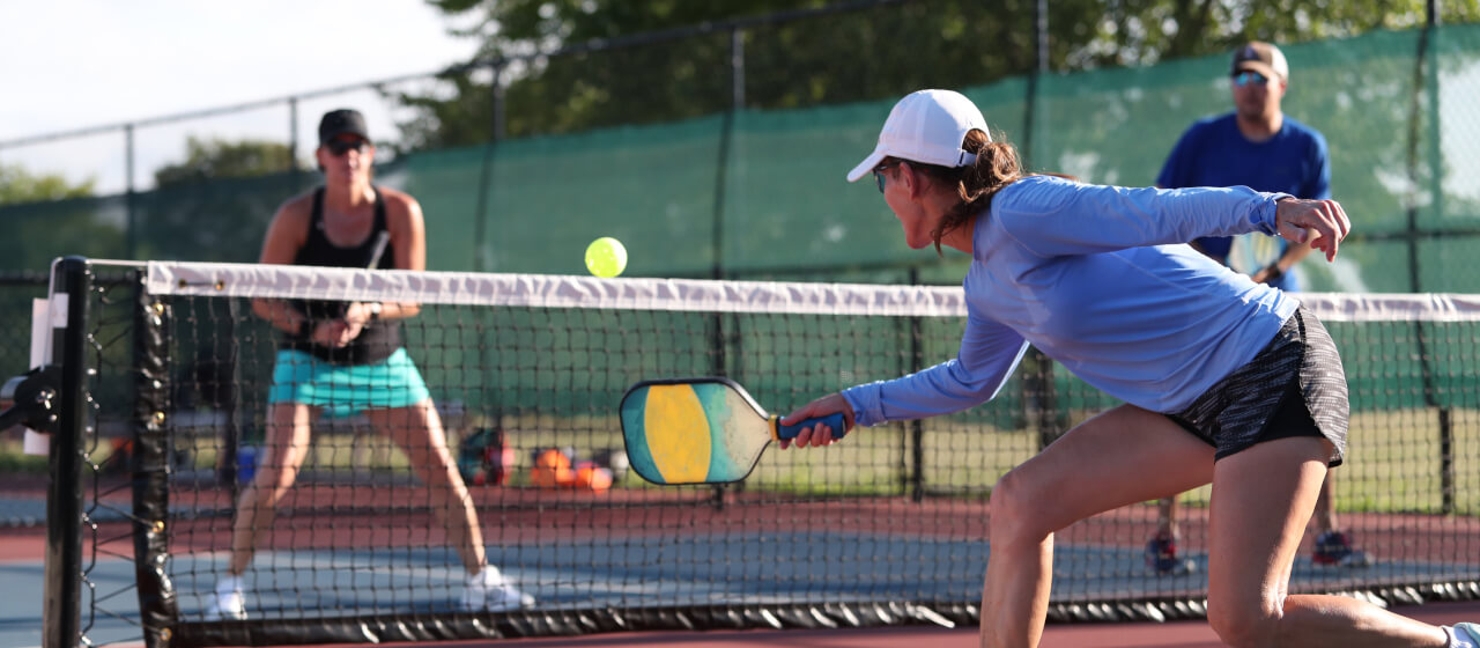
Growing nearly 40% this past year, there’s no denying that pickleball is taking the world by storm! With its fast-paced games and simple rules, it’s not hard to see why. If you’re looking to join the 4.8 million pickleball players in the U.S., you’ll need a paddle to start.
While you could certainly grab any old paddle and get going, players looking to optimize their natural skill choose their pickleball paddle size, shape, and weight intentionally. That way, you’ll always have the best advantage on the court.
In this guide, we’ve compiled everything you need to know about how pickleball paddles are constructed — and how those features affect your playstyle — to help you learn how to pick a pickleball paddle that’s right for you.
Anatomy of a Pickleball Paddle
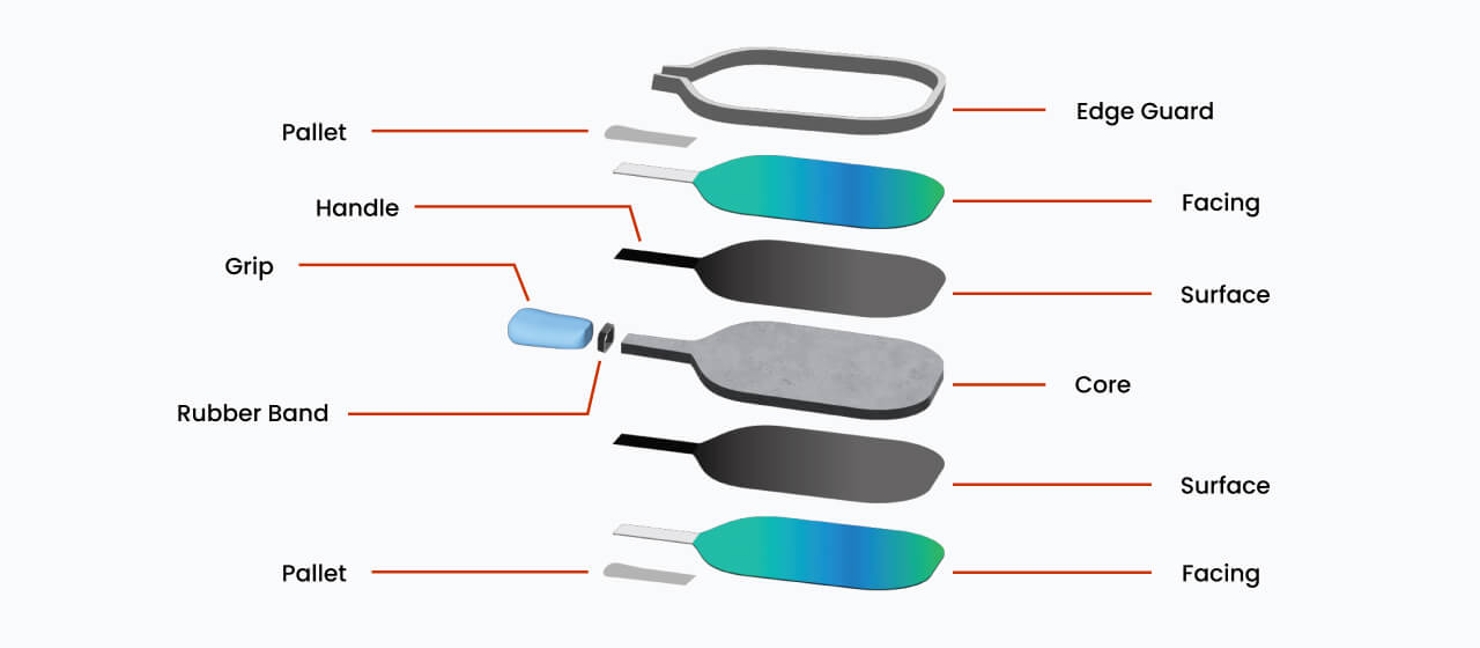
Understanding a pickleball paddle’s features and how they work is the first step to learning to choose a pickleball paddle. Just as the sport itself is a combination of badminton, tennis, and ping pong, these paddles are a similar combination of features that you may already be familiar with.
Different types of pickleball paddles may have various materials or place emphasis on a different key component, but they all share the following commonalities:
- Core: The innermost part of the paddle.
- Surface: The outermost part of the paddle.
- Facing: Any graphics, printing, or design on the surface.
- Edge guard: An outer protective border that ensures the layers don’t separate if struck.
- Handle: Where you grab onto the paddle.
- Pallets: Additional pieces that form the main shape of the paddle’s handle.
- Grip: A sometimes-textured piece of material that covers the handle and enhances grip.
- Rubber band: Connects the handle and grip to the rest of the paddle.
Expert Tip:
Although originally made of wood, the sport has seen a major shift in pickleball paddle innovation to improve its natural impact absorption, overall weight, and aerodynamics capabilities.
Most Important Factors for Choosing Your Paddle
All of the different components in a pickleball paddle add up to its impact on your game. If you’re looking to choose the best pickleball paddle for you, you’ll want to consider the following factors of any potential paddle:
Weight
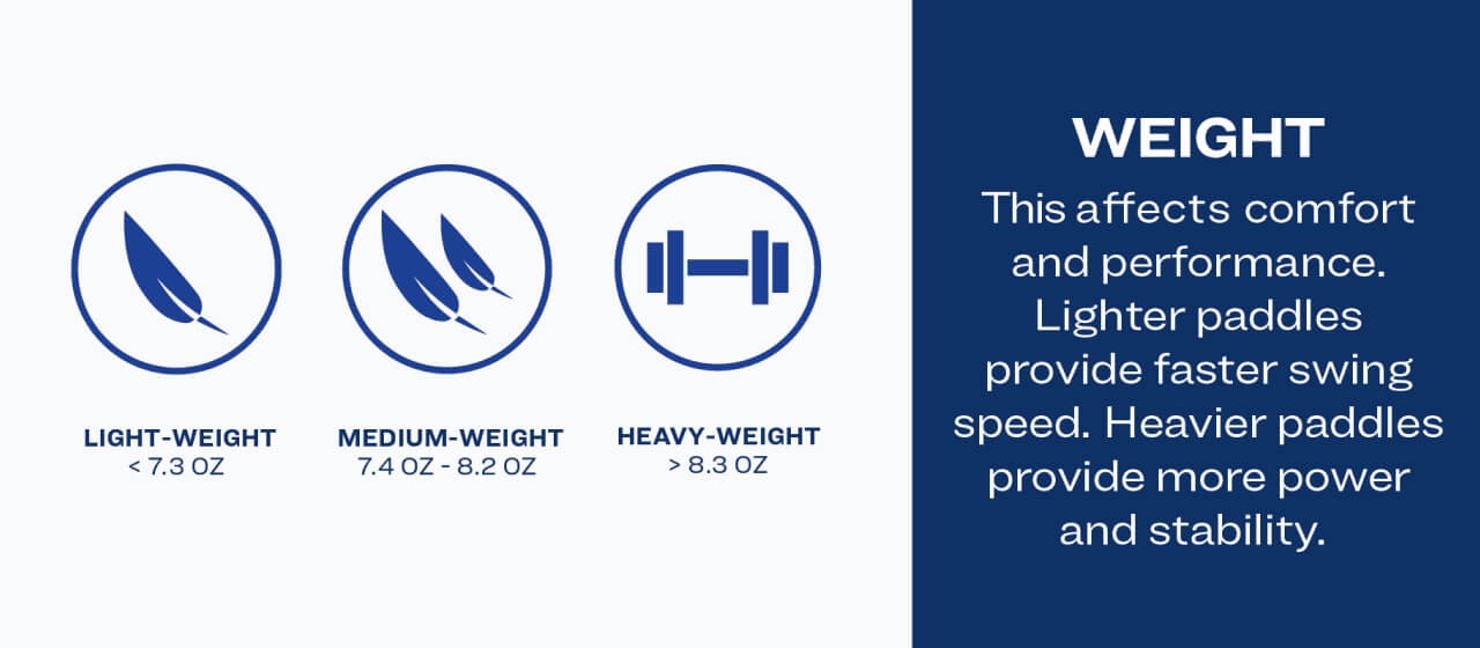
A pickleball paddle’s weight is arguably one of the most important factors to which new or beginner players should pay attention. You can always upgrade your paddle when your budget grows or as you improve your skills. But choosing a paddle that’s too heavy or too light for you can hurt your game right out of the gate:
- Lighter paddles provide faster swing speed.
- Heavier paddles give more power and stability.
Keep in mind that most paddle manufacturers tend to have their own weight categories, so it’s hard to compare apples to apples across them. To make things as simple as possible for you, we created our own standard and categorize them into the following three pickleball paddle weight classes:
| Pickleball Paddle Weight Chart | |||
|---|---|---|---|
| Criteria | Weight | Best For | Tradeoff |
| Light-weight | 7.3 ounces or less | New players who want an easier swing, better accuracy, and/or more wrist action | Offers less power |
| Mid-weight | 7.4-8.2 ounces | Players of any skill level looking for a balance of control and power or players unsure of what weight is right for them | Not specialized for either power or control |
| Heavy-weight | 8.3 ounces or more | Players with a strong swing and/or players who want a faster swing with more pop on the ball | Offers less control |
Light-Weight
- A lightweight paddle is generally anything weighing fewer or equal to 7.3 ounces. The general idea is that the lighter your paddle is, the easier it will be to swing it.
- They also offer greater control over the paddle, which means you can respond quickly and have greater accuracy in your dinks and drop-shots.
- On the flip side, the lighter your paddle is, the less weight there is behind each of your swings — meaning you’ll have less power and drive behind your shots.
- If you find yourself missing shots that are normally no problem for you, your paddle may be too light.
Mid-Weight
- Mid-weight paddles are any paddle that weighs between 7.4 and 8.2 ounces.
- They’re a great choice for beginners since they’re not too light and not too heavy, which balances power and control in equal measure. This gives you ample room to figure out what your preferred playstyle is or to switch up your playstyle between matches without switching paddles.
- If you purchase a mid-weight paddle as your first, take note of what you find yourself lacking over time, and then bring that knowledge to your next paddle purchase.
Heavy-Weight
- A heavyweight paddle is any paddle that weighs greater or equal to 8.3 ounces.
- These paddles are quite literally heavy hitters, providing lots of power behind each swing.
- They require more effort to swing, but that extra weight means they’ll travel as quickly as you do — resulting in a faster swing overall.
- All that power means some loss of control and accuracy as well.
- While having a monster swing with lots of pop sounds tempting to beginner players, choosing a paddle that’s too heavy for you to start with can cause fatigue more quickly or even lead to “tennis elbow” or wrist injuries. Be sure you know what you can handle before purchasing.
Core Material
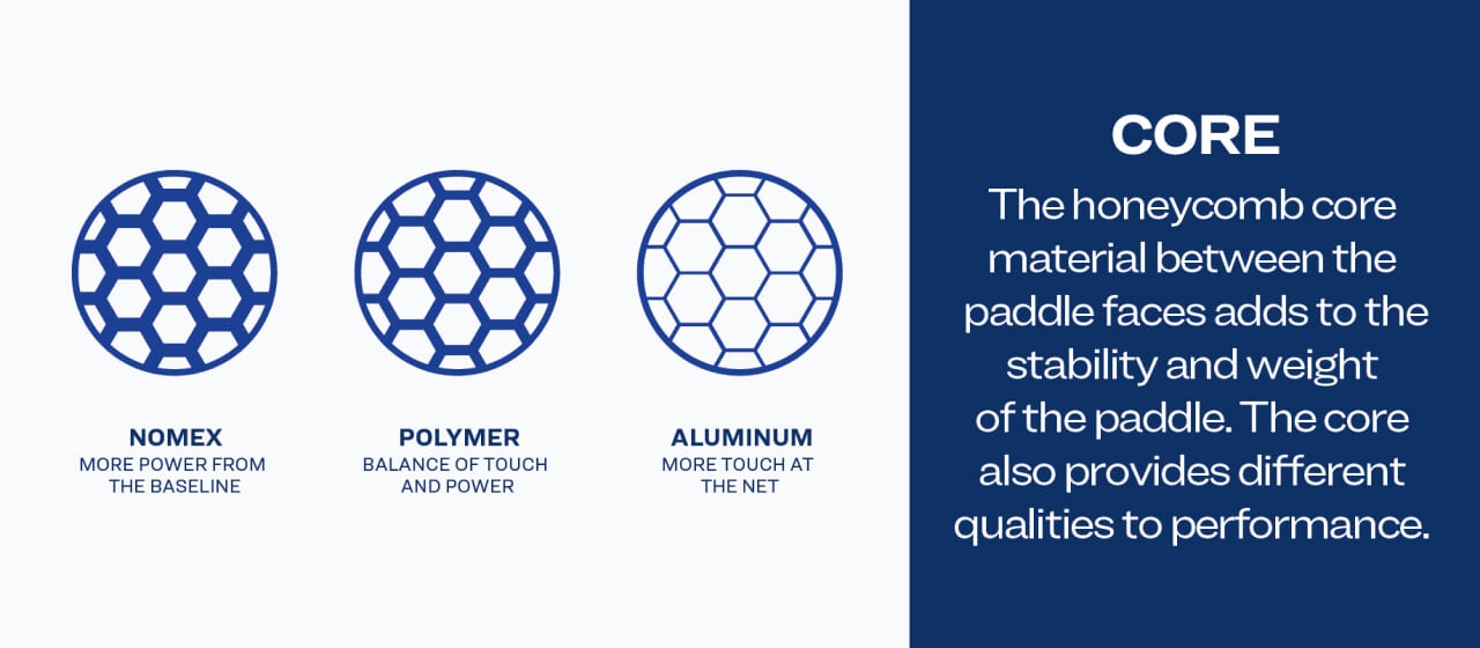
The honeycomb core affects the weight of your paddle and how the ball responds once making contact with it. It absorbs the force of your opponent’s swing on the ball to keep yours stable and under full control. The most common types of pickleball paddle cores are:
Polymer
Polymer core paddles like the Engage Sporting Status Pickleball Paddle use a blend of plastics to create a soft yet solid core. Because these cores are the softest on the market, they tend to offer greater shock absorption (and therefore greater control) — as well as some noise reduction, which is great if you play in a court near apartments, offices, or other areas.
Nomex
Nomex core paddles like the Onix Z5 Graphite Pickleball Paddle use a paper material with a honeycomb structure coated in resin to create the core. It is the heaviest core material on the market and fairly solid: offering that satisfying “pop” sound when striking the ball. Nomex is a highly durable material that is favored by pros and beginners alike.
Aluminum
Aluminum core paddles like the Franklin Revel Aluminum Paddle have a core made from the super-lightweight, familiar metal. While you won’t have the same driving power as with heavier core materials, aluminum core paddles offer serious control and maneuverability. However, they are not usually the most durable material out there.
Shape
To a beginner, pickleball paddles may all look fairly similar. Overall, there are certain aspects of a pickleball paddle shape that can’t be modified. However, subtle differences in shape can have a big impact on your game, since this influences how your paddle travels throughout your swing.
The rules of pickleball stipulate that no paddle can be over 24 total inches, which includes the handle and edge guard. Most types of pickleball paddles on the market right now fall into the following shape categories:

Standard
A standard pickleball paddle shape tends to be a squarish, rounded rectangle measuring about 16 inches long by 8 inches wide. Standard paddles like the Paddletek Phoenix G6 LTE Pickleball Paddle are classic — which is also another name for this specific paddle shape!
They offer a good balance of power and maneuverability, which is great for beginners. You can also find oversized paddles, which have the same squarish shape as the classic paddles but shorter handles to be compliant with the official rules.
Elongated
Elongated paddles are (as the name suggests) any paddle longer in shape than the standard 16 inches. To accommodate for this longer length, these paddles are smaller in width measurement. Because of their long length, these paddles offer superior reach and are great for singles players looking to cover extra ground during their game.
Elongated paddles like the Gamma Discovery Elongated Pickleball Paddle have a slightly higher ‘sweet spot’ for optimal striking. This may take some getting used to if you’ve only used standard paddles in the past.
Expert Tip:
Extra-elongated elongated paddles are called ‘blades.’
Teardrop
Teardrop paddles have an inverted teardrop shape, starting wide at the top of the paddle and tapering toward the handle. This unique shape balances the weight across the paddle (so it’s not too top-heavy) — creating a wider, generously-sized ‘sweet spot’ that’s easier to hit while still maintaining maneuverability. Paddles like the HEAD Gravity Lite Pickleball Paddle are surprisingly welcoming to beginner players and seasoned pros alike.
Wide Body
Wide body paddles like the Onix Z5 Graphite Pickleball Paddle are any paddle with a width greater than the classic 8 inches. They are the inverse of elongated paddles — in that they are wider than they are tall. This width creates an extremely forgiving paddle with a very generous ‘sweet spot’ that is easy to hit. It’s a great choice for beginners, but you will lose out on some control in play due to its chunky shape.
Surface Material
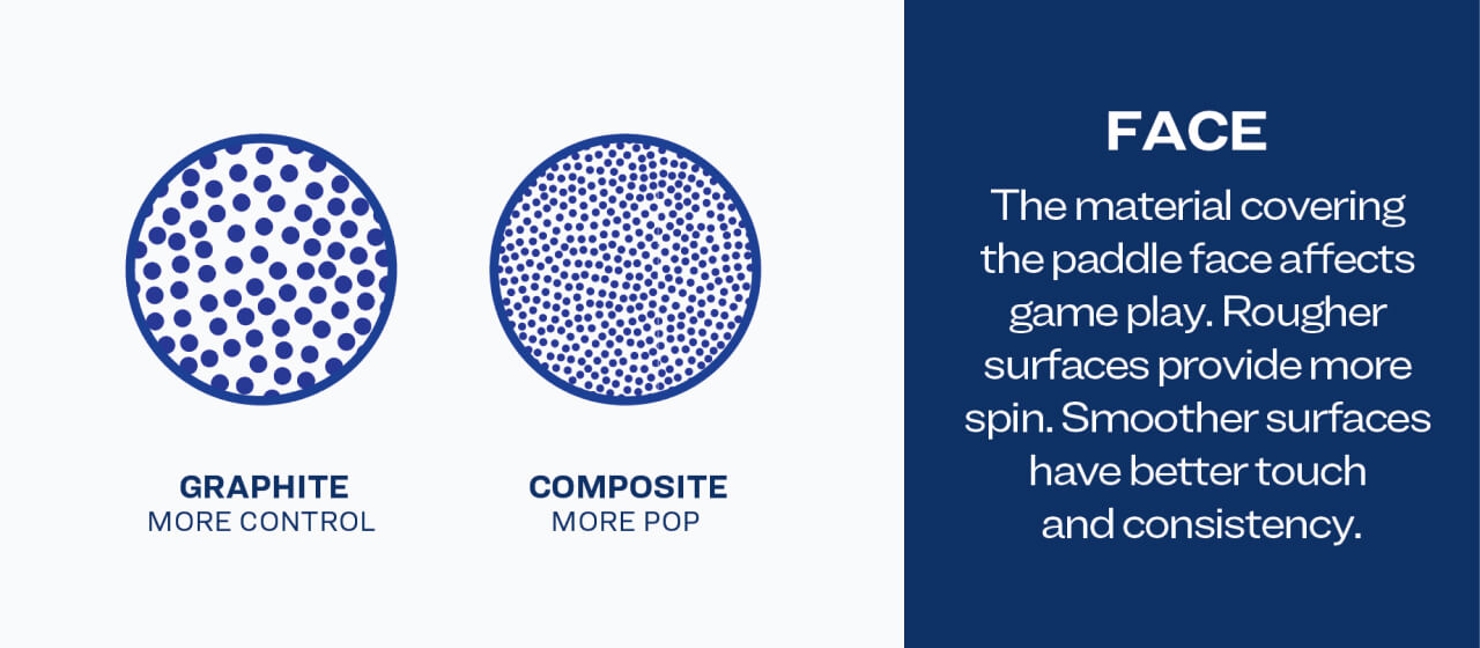
The surface (or face) is the material that covers the core and determines the direction of the ball when hit. This textured surface creates a grip that adds control and accuracy to each swing. It can affect gameplay in two ways:
- Rougher surfaces provide more spin.
- Smoother surfaces have better touch and consistency.
Different types of material used in a pickleball paddle’s surface will influence a paddle’s control, power, and sweet spot size. Consider the following when choosing the right pickleball paddle for you:
| Outer/Surface Material Comparison Chart | |||||
|---|---|---|---|---|---|
| Criteria | Carbon Fiber | Graphite | Fiberglass | ||
| Durability | Best | Better | Good | ||
| Control | Best | Better | Good | ||
| Power | Good | Better | Best | ||
| Affordability | Good | Better | Best | ||
Carbon Fiber
Carbon fiber is an ultra-strong material used in a variety of mechanical and sports applications, including pickleball paddle faces! A newer (and therefore more cost-associated) material on the market, carbon fiber’s unique, dense texture helps slow the ball as it makes contact with your paddle. This allows you to receive any shot and return it as you’d like — whether that’s with a hard slam or a dink.
The result is a little bit of a power tradeoff since less energy is transferred back into the ball once it’s slowed. A paddle with a carbon fiber surface like the Selkirk Sport EVO Soft XL Pickleball Paddle is a great choice for a beginner who wants a lot of control over their shots and is willing to invest a little right away in a new hobby.
Graphite
Graphite isn’t just for pencils! A key component of carbon fiber, graphite can be used on its own to produce a similar effect for a lower price. Paddles with a graphite surface like the Gamma Compass NeuCore Pickleball Paddle offer a lightweight, grippy experience with a decent amount of control and power.
Each is perfect for beginners ready to have fun out there right away. However, graphite paddles can be less durable than their counterparts, so you’ll need to take care of where you put it and how you store it between games.
Fiberglass or Composite
Fiberglass (also referred to as composite) paddles like the Franklin X1000 Pickleball Paddle use a fiberglass material to create a soft, flexible surface. It offers superior power, as your paddle’s surface will serve as a trampoline for your opponent’s serve or slam — sending their energy right on back to them like a jiu-jitsu throw.
Once the most common type of pickleball paddle surface material, fiberglass surfaces are easy to find at a reasonable price but tend to lack durability due to their softness.
Handle Length
Your pickleball paddle’s handle is the source of your swing, so it’s crucial that you find a length that suits your style of play. Most paddle handle lengths fall between 4.5 to 6 inches, and the right length for you depends on your preference for holding it.
-
Using two-hand preference: Players who prefer using two hands on the handle at all times should choose a pickleball paddle at least 5.25 inches in length. Depending on the size of your hands, you may need a longer handle.
-
Using one-hand preference: Players who only use a single hand on the handle should choose a paddle with a handle length of no more than 5 inches. Depending on the size of your hand, you may need a shorter handle.
-
Using both preferences: If you have a more fluid play style, you should choose a handle length of about 4.75 inches to 5.25 inches, depending on the size of your hands.
Grip Size
The length of your paddle’s handle isn’t the only thing you should consider. Grip size influences the width of your paddle’s handle, which can help or hurt your elbow as you play. Always take paddle ergonomics seriously so you don’t have to sit out on your next game.
Grips too large for your hands can potentially slip out of them and lead to injuries. Meanwhile, smaller grips grant players improved wrist action — offering better spin and control. However, larger grips provide players with better stability while swinging.
There are two popular ways to easily determine your perfect grip size. At the end of the day, player preference always supersedes any recommendation you find online.
Grip Size Based on Height
A quick-start way to determine an appropriate grip size for your paddle is to use your height as a basis. We’ve put together this recommendation based on general hand sizes associated with height ranges, but if your hands are smaller or larger for your size, feel free to adjust where needed.
- 5’2” or shorter: 4-inch grip recommended
- 5’3” to 5’8”: 4.25-inch grip recommended
- 5’9” or taller: 4.5-inch grip recommended
Grip Size Based on Finger Length
If you want a more precise grip fit, you can take a quick measurement of your hand. This method measures the length between your palm and the edge of your finger and takes only four easy steps:

- Step 1: Find (and mark, if you wish) the middle crease on the palm of your preferred playing hand. (For most people, this is your dominant hand.)
- Step 2: On that same hand, find (and mark, if you wish) the center of the tip of your ring finger.
- Step 3: Using a tape measure or ruler, measure the distance between those two points.
- Step 4: Use that measurement to purchase a similarly-sized grip!
Price
Even though pickleball seems to be taking the world by storm, it has yet to hit the ubiquity found in sports like baseball or football — which can translate to associated costs. As the sport grows, more affordable types of pickleball paddles are hitting stores, but it may not be possible to get a paddle with the exact specs you want with your starting budget. And that’s okay!
We recommend most beginner pickleball players choose a paddle that helps them learn the sport first and foremost. Like with any new hobby, the most important part of learning to play pickleball is developing your enthusiasm and routine first. You can always upgrade your gear later once your budget has changed or your skills have developed. But nobody wants to drop huge stacks of fancy equipment only to have it gather dust in the garage.
Next Steps
At Academy Sports, we want to help you have fun out there on the court with the paddle that’s right for you. That’s why we offer a wide range of pickleball paddles with many types of core materials, surface materials, paddle shapes, and more available to choose from, in-store and online. Looking for nets, balls, and other pickleball accessories? Check out our pickleball shop.


